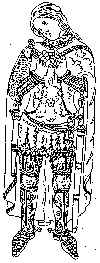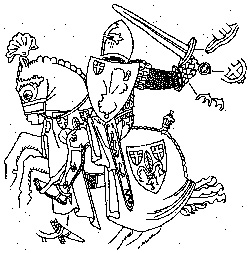 This comprehensive and lavishly illustrated volume by David Nicolle details the armies, arms and equipment of western and central European states, and their client kingdoms in the Middle East, in over three centuries of military development and almost continuous warfare. Covering a decisive period in world history, when Christendom, Islam and the Mongol world came into violent and sustained conflict, this definitive study pinponts the evolving military sciences, technologies and practices of Europe in an era of revolutionary change.
This comprehensive and lavishly illustrated volume by David Nicolle details the armies, arms and equipment of western and central European states, and their client kingdoms in the Middle East, in over three centuries of military development and almost continuous warfare. Covering a decisive period in world history, when Christendom, Islam and the Mongol world came into violent and sustained conflict, this definitive study pinponts the evolving military sciences, technologies and practices of Europe in an era of revolutionary change.
Arms and Armour of the Crusading Era, 1050–1350: Western Europe and the Crusader States combines a vivid commentary on key aspects of each western and central European army with hundreds of superbly detailed line drawings based on years of research into archaeological evidence and an examination of the pictorial arts of the period. With chapters on Portugal, France, Castille, Aragon, Ireland, England, the Holy Roman Empire, the Italian kingdoms and the Latin kingdoms of the Outremer, amongst others, this is a valuable work of broad scope which captures the spirit of warfare in the crusading era.
The second volume, Arms and Armour of the Crusading Era, 1050–1350: Islam, Eastern Europe and Asia, will be published in the second half of this year.
David Nicolle is well known as a leading historian of Middle Eastern and Islamic military history. His numerous books include The Mongol Warlords, The Medieval Warfare Source Book, The Hamlyn History of Medieval Life and Saracen Faris, 1050–1250AD and many books for Osprey. In his Introduction Dr Nicolle says:
 European arms, armour and military technology have been studied for many years in many countries. All too often, however, such studies have focused upon one 'nation', even when that nation did not exist in medieval times, or have assumed too great a degree of uniformity across the whole of western Christendom. The serious study of Byzantine, Islamic, Central Asian, Indian and Far Eastern arms has been a more recent phenomenon but is already suffering from the same parochialism or oversimplification. Nevertheless, it is becoming increasingly obvious that while there was considerable regional variation within each of the great religiously based civilisations of what Europeans call the Middle Ages, there were also varying degrees of stylistic, technological or fashionable influence spreading from one civilisation to another. This seems to have been particularly true of the period under view, which may seem surprising given the fact that this era has been characterised as one of distinct and separate regions. Such varied influences are perhaps more obvious in the early medieval period (5th to 10th centuries), when Byzantium was the main stylistic leader in Europe, than in the Crusading era (11th to 14th centuries) which is the subject of this book. On the other hand the 11th to 14th centuries saw the emergence of greater regional variation across Europe, and indeed Christendom as a whole. Furthermore, such variation reflected both local developments and the influence of neighbouring regions, particularly when the latter did not themselves fall within the medieval Christian world.
European arms, armour and military technology have been studied for many years in many countries. All too often, however, such studies have focused upon one 'nation', even when that nation did not exist in medieval times, or have assumed too great a degree of uniformity across the whole of western Christendom. The serious study of Byzantine, Islamic, Central Asian, Indian and Far Eastern arms has been a more recent phenomenon but is already suffering from the same parochialism or oversimplification. Nevertheless, it is becoming increasingly obvious that while there was considerable regional variation within each of the great religiously based civilisations of what Europeans call the Middle Ages, there were also varying degrees of stylistic, technological or fashionable influence spreading from one civilisation to another. This seems to have been particularly true of the period under view, which may seem surprising given the fact that this era has been characterised as one of distinct and separate regions. Such varied influences are perhaps more obvious in the early medieval period (5th to 10th centuries), when Byzantium was the main stylistic leader in Europe, than in the Crusading era (11th to 14th centuries) which is the subject of this book. On the other hand the 11th to 14th centuries saw the emergence of greater regional variation across Europe, and indeed Christendom as a whole. Furthermore, such variation reflected both local developments and the influence of neighbouring regions, particularly when the latter did not themselves fall within the medieval Christian world.
The contents of Arms and Armour of the Crusading Era include:
- Northern France
England and Wales
Scotland
Ireland
Southern France
Aragon, Navarre and Catalonia
Leon and Castilev Portugal
The Emipre – Germany
The Empire – Bohemia
The Empire – Arles
The Empire – Italy
Southern Italy and Sicily
The Crusader States
The Western Balkans
Hungary
Poland
Scandinavia
The Baltic Peoples
Dictionary of Terms
Bibliographies
Back to Greenhill Military Book News No. 89 Table of Contents
Back to Greenhill Military Book News List of Issues
Back to Master Magazine List
© Copyright 1999 by Greenhill Books
This article appears in MagWeb (Magazine Web) on the Internet World Wide Web.
Other military history articles and gaming articles are available at http://www.magweb.com